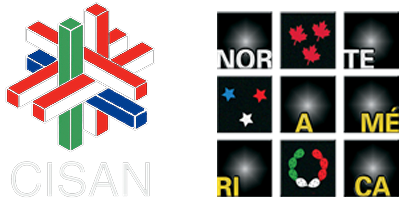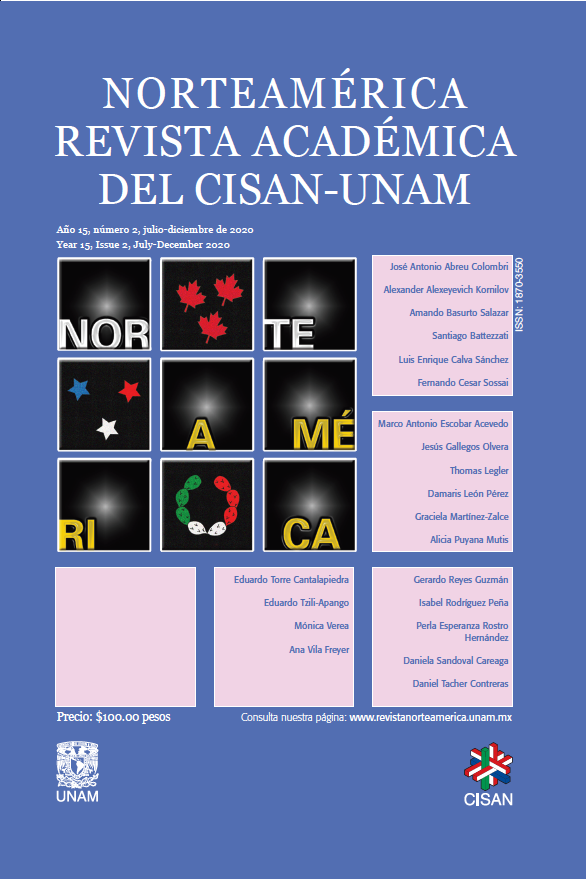Resumen
El presente artículo analiza la importancia del voto latino en las elecciones presidenciales de 2020 en Estados Unidos, considerando el incremento de esta población en los últimos veinte años y su composición por grupos nacionales. Se documenta dicho crecimiento como producto de los flujos migratorios, en contraste con su tendencia a convertirse en ciudadanos estadouni-denses, que afecta su peso electoral. Por último, se establece su ubicación geográfica a fin de considerar el peso electoral en los “estados columpio” (swing states), donde tiene lugar la ma-yor competitividad para la conformación del Colegio Electoral.
Citas
Desipio, Louis
“Immigrant Organizing, Civic Outcomes: Civic Engagement, Political Activity, National Attachment, and Identity” en Latino Immigrant Communities. Center for the Study of Democracy, Paper #02–08, disponible en http://repositories.cdlib.org/csd/02–08, consultado el 19 de mayo de 2020.
Escobar, Cristina
“Dual Citizenship and Political Participation: Migrants in the Interplay of United States and Colombian Politics”,en Latino Studies, 2/1, pp. 45–69.
Galbraith, Quinn y Callister, Adam
“Why Would Hispanics Vote for Trump? Explaining the Controversy of the 2016 Election”, en: Hispanic Journal of Behavioral Sciences, Vol. 42(1), pp. 77–94.
Gómez-Quiñones, Juan
Chicano Politics: Realities and Promise, University of New Mexico Press, Albuquerque.
Gonzalez-Barrera Ana
junio ”Mexican Lawful Immigrants Among the Least Likely to Become U.S. Citizens”, disponible en: <https://www.pewresearch.org/hispanic/2017/06/29/mexican-lawful-immigrants-among-least-likely-to-become-u-s-citizens/> consultado el 19 de mayo de 2020.
Jensen, Lief, Cohen, Jeffrey, Toribio, Jaqueline Almeida, Dejong, Gordon, y Rodriquez, Leila
“Ethnic Identities, Language, Economic Outcomes among Dominicans in a New Destination”, en Social Science Quarterly, 87/1, pp. 1088–99.
Johnson, Martin, Stein, Robert, y Wrinkle, Robert
“Language Choice, Residential Stability, and Voting among Latino Americans”, en Social Science Quarterly, 84/2, pp. 412–24.
Jones-Correa, Michael
Between Two Nations: The Political Predicament of Latinos in New York City, Cornell University Press, Ithaca, New York.
Jones-Correa, Michael y Leal, David
“Becoming “Hispanic”: Secondary Pan-ethnic Identification among Latin American-Origin Populations in the United States”, en Hispanic Journal of Behavioral Sciences, 18/2, pp. 214–54.
Kumar, Anita y Ordoñez, Franco
septiembre, “Trump talks tough on immigration in Nevada but it could backfire”, disponible en: https://www.mcclatchydc.com/ news/politics-government/white-house/article218719245.html consultado el 29 de arbil de 2020.
Landale, Nnacy, y Oropesa, Ralph Salvador
“White, Black, or Puerto Rican? Racial Self-identification Among Mainland and Island Puerto Ricans#, en Social Forces, 81/1, pp. 231–54.
Marschall, Melissa
“Does the Shoe Fit? Testing Models of Participation for African-American and Latino Involvement in Local Politics”, en Urban Affairs Review, 37/2, pp. 227-48.
Mora, G. Cristina
Making Hispanics: How Activists, Bureaucrats, and Media Constructed a New American, University of Chicago Press, Chicago.
Pantoja, Adrian, Ramirez, Ricardo, y Segura, Gary
“Citizens by Choice, Voters by Necessity: Patterns in Political Mobilization by Naturalized Latinos”, en Political Research Quarterly, 54/4, pp. 729–50.
Pew Research Center
“U.S. Unauthorized Immigrant Total Dips to Lowest Level in a Decade”, disponible en: <https://www.pewresearch.org/hispanic/wp-content/uploads/sites/5/2019/03/Pew-Research-Center_2018-11-27_U-S-Unauthorized-Immigrants-Total-Dips_Updated-2019-06-25.pdf> consultado el 15 de mayo de 2020.
Pew Research Center
“Naturalized Citizens Make Up Record One-in-Ten U.S. Eligible Voters in 2020”, disponible en: <https://www.pewresearch.org/hispanic/2020/02/26/naturalized-citizens-make-up-record-one-in-ten-u-s-eligible-voters-in-2020/> consultado el 26 de abril de 2020.
Portes, Alejandro y Macleod, Dag
“What Shall I Call Myself? Hispanic Identity Formation in the Second Generation”, en Ethnic and Racial Studies 19/3, pp. 523–47.
Sanchez, Gabriel
“The Role of Group Consciousness in Political Participation among Latinos in the United States” en American Politics Research, 34, pp. 427–50.
Soergel, Andrew
febrero. “In 2020, 1 in 5 California Voters Will Be Foreign-Born. One-tenth of all eligible American voters, and one-fifth of all eligible Californians, will be foreign-born on Election Day 2020”, disponible en: <https://www.usnews.com/news/best-states/articles/2020-02-28/on-election-day-2020-1-in-5-california-voters-will-be-foreign-born> consultado el 8 de mayo de 2020.
Stokes, Atiya Kai
“Latino Group Consciousness and Political Participation”, en American Politics Research, 31, pp. 361–78.
Taylor, Paul, Lopez, Mark Hugo, Martínez, Jessica y Velasco, Gabriel
“When labels don´t fit: Hispanics and their views of identity”, disponible en: <https://www.pewhispanic.org/2012/04/04/when-labels-dont-fit-hispanics-and-their-views-of-identity/> consultado el 12 de mayo de 2020.
U.S. Census Bureau
“Census 2000 PHC-T-25. Migration by Race and Hispanic Origin for the Population 5 Years and Over for the United States, Regions, States, and Puerto Rico: 2000”, disponible en: <https://www2.census.gov/programs-surveys/decennial/2000/phc/phc-t-25/tab01.pdf?#> consultado el 12 de mayo de 2020.
U.S. Census Bureau
“2019 National and State Population Estimates”, disponible en: <https://www.census.gov/newsroom/press-kits/2019/national-state-estimates.html> consultado el 12 de mayo de 2020.
U.S. Census Bureau
“National Population Totals and Components of Change: 2010-2019”, disponible en: <https://www.census.gov/data/tables/time-series/demo/popest/2010s-national-total.html> consultado el 12 de mayo de 2020.

Esta obra está bajo una licencia internacional Creative Commons Atribución-NoComercial-SinDerivadas 4.0.
Derechos de autor 2020 Daniel Tacher Contreras



